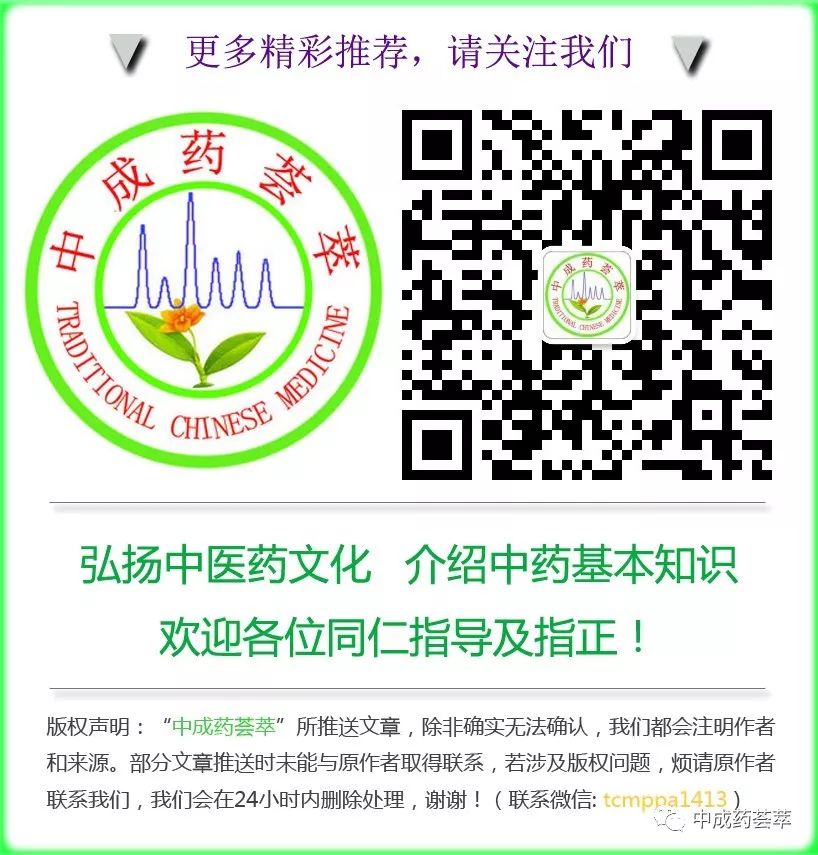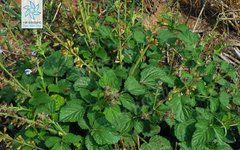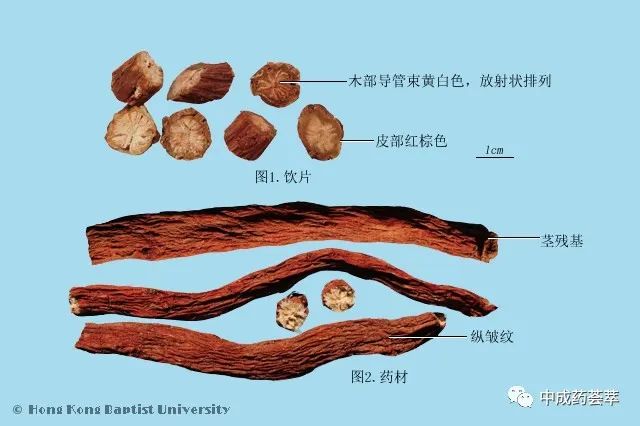
Identification Points☝
Premium Chinese Herbal Medicine | Danshen (Salvia miltiorrhiza)
This product is the dried root and rhizome of the Lamiaceae plant Danshen (Salvia miltiorrhiza Bge.). It is harvested in spring and autumn, cleaned of soil, and dried.【Characteristics】The rhizome is short and thick, sometimes with remnants of the stem base at the top. There are several roots, long cylindrical, slightly curved, some branched with fine fibrous roots, measuring 10-20 cm in length and 0.3-1 cm in diameter. The surface is reddish-brown or dark reddish-brown, rough, with longitudinal wrinkles. The outer skin of old roots is loose, often showing a purple-brown color, and tends to flake off in scales. The texture is hard and brittle, with a loose fracture surface that may have cracks or be slightly flat and dense, with the bark being reddish-brown and the wood gray-yellow or purple-brown, and the vascular bundles arranged radially in yellow-white. The aroma is faint, and the taste is slightly bitter and astringent. Cultivated varieties are sturdier, with a diameter of 0.5-1.5 cm. The surface is reddish-brown, with longitudinal wrinkles, and the outer skin adheres tightly and is not easily peeled off. The texture is solid, and the fracture surface is relatively flat, slightly keratinous.【Taste and Meridian Affinity】Bitter, slightly cold. It enters the Heart and Liver meridians.【Functions and Indications】Invigorates blood circulation and removes stasis, regulates menstruation and alleviates pain, clears the heart and relieves irritability, cools the blood and resolves abscesses. It is used for chest obstruction and heart pain, abdominal and flank pain, masses and accumulations, heat bi pain, irritability and insomnia, menstrual irregularities, dysmenorrhea, and painful obstruction, as well as for sores and swelling pain.
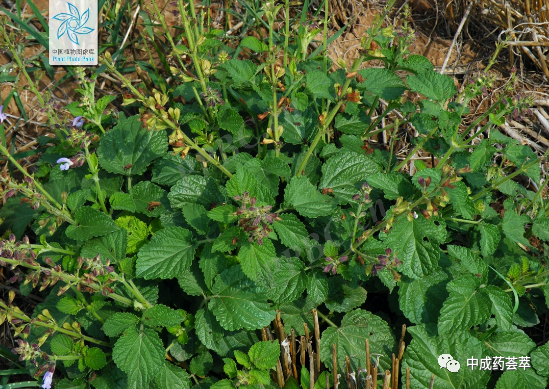
Original Plant:
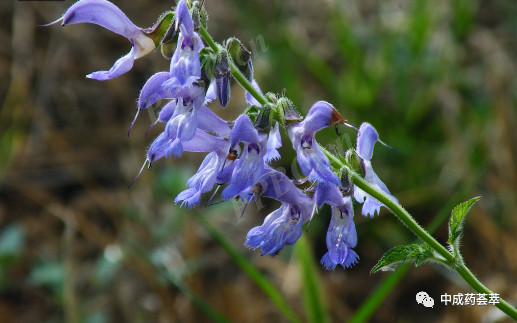
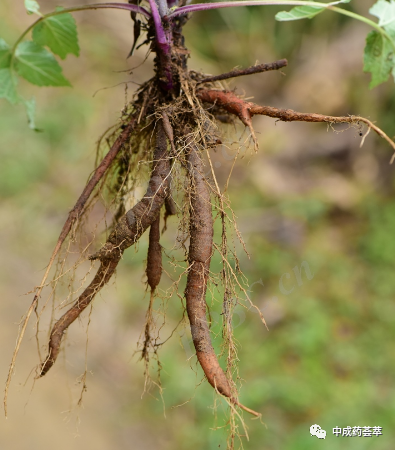
135
Herbal Material/Processed Slices:
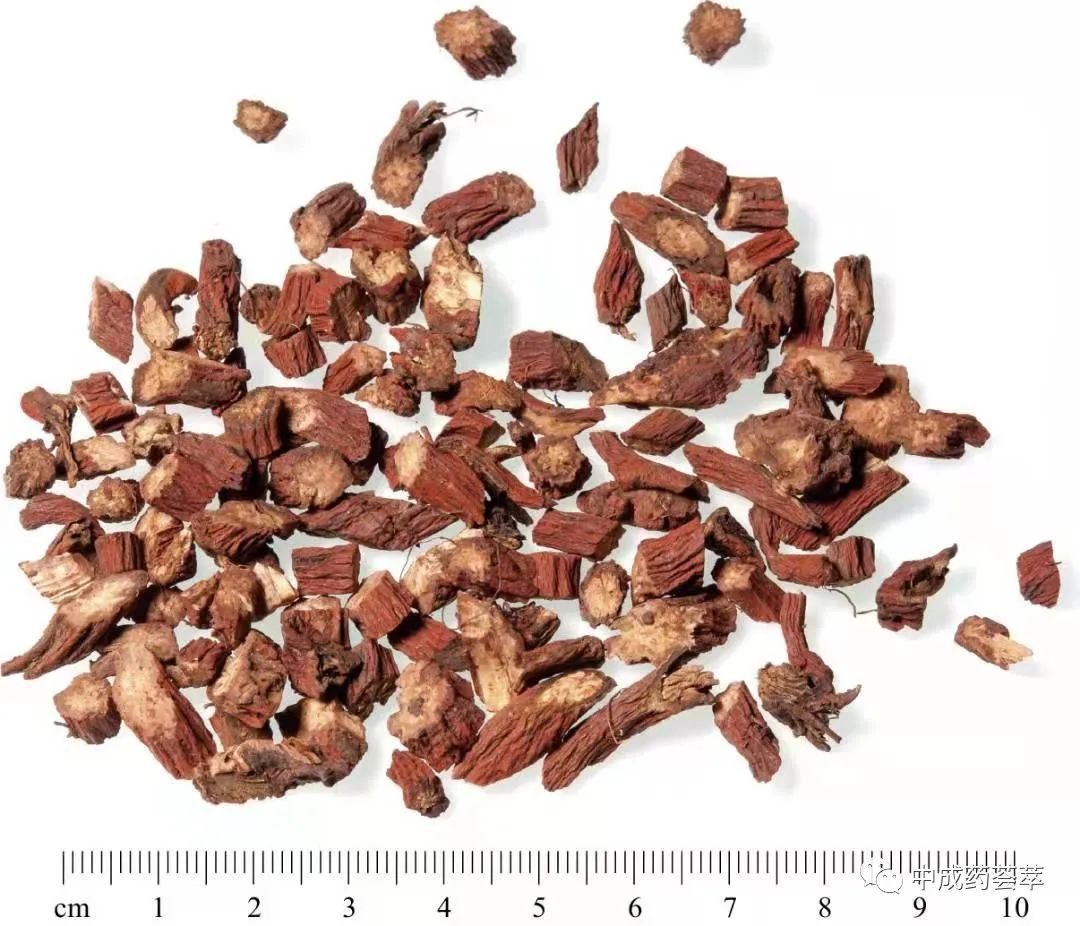
Specification Grades:
According to market circulation, Danshen is classified into three specifications based on its origin: “Chuan Danshen,” “Shandong Danshen,” and “other regional Danshen.” The classification of herbal materials into grades is divided into “selected goods” and “common goods.” The selected goods of “Chuan Danshen” are further divided into four grades: “special grade,” “first grade,” “second grade,” and “third grade,” while the selected goods of “Shandong Danshen” are divided into “first grade” and “second grade.” Note 1: Currently, the market classification of Danshen is based on its origin, including Chuan Danshen, Shandong Danshen, and Danshen from Shanxi, Anhui, Hebei, Henan, and Shaanxi. The classification is primarily based on the diameter of the root, with larger diameters indicating higher grades. Additionally, Chuan Danshen has a long cultivation history, and traditional grading is often based on diameter, primarily for export, while other regions have simpler grading, mostly dividing into selected and common. The characteristics may vary slightly by region, and differentiation should be noted. Note 2: Market surveys have found that wild Danshen does not form a mainstream commodity, and some markets sell Yunnan Danshen or Gansu sage as wild Danshen, which should be carefully identified. Note 3: Currently, there are many processed Danshen slices on the market, which vary in size and thickness. Some herbal markets also have slanted slices and Danshen segments. These products do not comply with the 2015 edition of the “Chinese Pharmacopoeia” regulations for Danshen herbal materials and should be distinguished. Note 4: In addition to normal Danshen, there are also many sulfur-fumigated Danshen on the market. Sulfur-fumigated Danshen has a faint odor and a white, semi-transparent keratinous fracture surface. The residual sulfur dioxide content in these products may exceed standards, and differentiation should be noted. Note 5: The concept of common goods in the market is somewhat confused; some common goods refer to unselected herbal materials, while others refer to selected and graded Danshen herbal materials. Currently, unselected herbal materials are uniformly referred to as common goods. Note 6: There is also sweating Danshen on the market, which differs from ordinary Danshen in that its fracture surface is black, while other aspects are not significantly different, hence it is not listed separately in specifications. Note 7: The standard respects the traditional method of grading based on characteristics, specifically diameter size. However, it should be noted that the distribution of danshens in the root bark leads to a phenomenon where traditional grading is inversely proportional to its content. This phenomenon is common among many rhizome-type herbal materials. Currently, there is no clear conclusion regarding the relationship between indicator components and efficacy, and the standard adopts a respectful attitude towards tradition. However, it should be noted that the application of root expansion agents in recent years has led to issues with diameter grading, which should be taken seriously to avoid using such growth-regulating hormones.Herbal Material Requirements:
No fibrous roots;
No fine roots;
No insect damage;
No mold;
Impurities less than 3%.
Different Specification Grades of Herbal Materials:
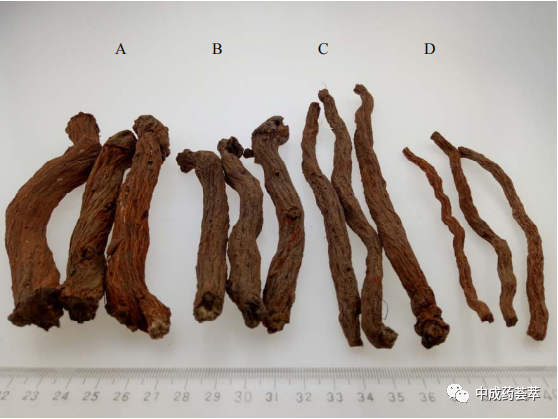
A, Chuan Danshen Special Grade; B, Chuan Danshen First Grade;
C, Chuan Danshen Second Grade; D, Chuan Danshen Third Grade.
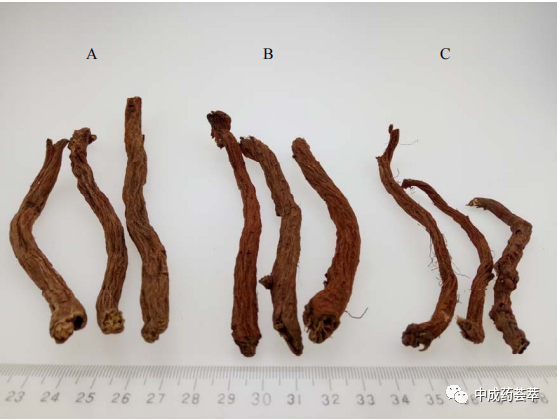
A, Shandong Danshen First Grade; B, Shandong Danshen Second Grade; C, Shandong Danshen Common Goods.
Overview:
Historical literature prior to the Tang dynasty does not provide detailed descriptions of the quality evaluation of Danshen. It was not until the Tang dynasty’s “Newly Revised Materia Medica” that records appeared: “This herb is best harvested in winter, and poorly harvested in summer.” The Song dynasty’s “Illustrated Materia Medica” states: “Those harvested in winter are good, while those harvested in summer are poor.” The Ming dynasty’s “Essentials of Materia Medica” provides a more detailed description of the origin and quality evaluation of Danshen: “Use: the thicker the root, the better” and “Authentic: Suizhou.” “Those harvested in winter are good, while those harvested in summer are not very good.” The “Commentary on the Materia Medica” states: “Those from the north are better, commonly known as ‘Chasing Horses’.” Zheng Eryang’s “Ren Shou Tang Herbal Mirror” states: “The skin is red and the flesh is purple, which is better.” “Yisheng Weilun” states: “Moist and salty is better.” Ming dynasty’s Xu Xizhou’s “Rough Evaluation of Medicinal Properties” states: “In February, seedlings grow to about one foot high, with square stems, green color, leaves resembling mint, opposite and hairy, flowering in March with red-purple flowers resembling purple perilla flowers, roots red, large as fingers, over a foot long, with several roots per stem. It is found in various valleys in the north and south. The roots are harvested in May and dried in the sun. It is said that those harvested in winter are better.” Ming dynasty’s Lu Zhi Yi’s “Half Verse of Materia Medica” states: “He Ke says: … In February, seedlings grow to about one foot high, with square stems and ridges. One branch has five leaves, opposite, like mint leaves and hairy. From March to September, small flowers bloom in spikes resembling moth shapes, with fine seeds. One seedling has several roots, roots large as fingers, over a foot long, and those harvested in winter are better.” The Qing dynasty’s “Commentary on Materia Medica” states: “Those harvested in winter are better.” The “Commentary on Materia Medica” states: “Sellers often dye the product, so it must be distinguished. Those harvested in winter are better… Summer harvesting leads to loss of qi, so roots must be harvested in winter, otherwise, it is contrary to the original intention to obtain the full essence of gold and water for the use of flourishing wood and fire.” The Republic of China’s “Revised Pseudo-Medicinal Dispute” states: “Danshen from the ancient city of Anhui has red skin and purple flesh with patterns. The quality is dry and loose, with a large head and no fibrous roots being the best. Products from Chuzhou and Quanjiao counties have similar shapes and are also good. Products from Fengyang, Dingyuan, and Baiyang Mountain are fine and loose, with many fine branches. Products from Sichuan have small heads and coarse branches, with glutinous flesh and white hearts, which are inferior. Zheng Jun’s so-called ‘local Danshen’ may refer to Chuan Danshen. Alternatively, it may be a type of local product from Fujian, with a distinct morphology, which I have not seen.” The “Identification of Medicinal Products” states: “The best Danshen is from Long’an Prefecture in Sichuan (now Pingwu County, Sichuan), known as Chuan Danshen.” The 1963 edition of the “Chinese Pharmacopoeia” states: “The best is thick, purple-red, and without fragments.” The 1977 edition states: “The best is thick and purple-red.” The 1984 promulgation of the “Standard Specifications for 76 Medicinal Materials” divided Danshen into two specifications: wild Danshen and cultivated Chuan Danshen. In summary, throughout history, the classification of Danshen has emphasized the quality of its origin, with Chuan Danshen and Shandong Danshen being the authentic medicinal materials, and evaluations based on characteristics such as skin color and root thickness provide a basis for establishing Danshen product specification standards.
Danshen was first recorded in the “Shennong Bencao Jing” as a top-grade herb, “with a bitter and slightly cold taste. It is indicated for heart and abdominal evil qi, intestinal sounds like flowing water, cold and heat accumulation, breaking masses and removing accumulations, stopping irritability and fullness, and benefiting qi. It is also known as Quechan grass. It grows in valleys.” Subsequent materia medica throughout the ages have included it.
Records of Danshen’s origin began in the “Record of Famous Physicians”: “It grows in Tongbai Mountain (now within Nanyang, Henan) and in the valleys of Chuan and Taishan (now around Tai’an, Shandong), with roots harvested in May.” This indicates that at that time, Danshen was produced in Tongbai, Henan, and Tai’an, Shandong.
The Southern Dynasties’ “Commentary on the Materia Medica” provided a more detailed explanation of “Tongbai Mountain”: “This Tongbai Mountain (now within Tongbai County, Henan) is the mountain from which the Huai River originates, located in Yiyang (Yiyang Kingdom, now southern Henan and northern Hubei), not the Tongbai by the sea in Jiangdong.” This clarifies that the Tongbai Mountain referred to by predecessors is the Tongbai County in Nanyang, Henan, not the coastal Tongbai in Jiangdong.
The Song dynasty’s “Taiping Yulan” states: “It grows in Tongbai (now within Tongbai County, Henan) or in the mountains and hills of Taishan (now around Tai’an, Shandong).” The “Illustrated Materia Medica” describes it as: “It grows in Tongbai Mountain valleys (now within Tongbai County, Henan) and Taishan (now around Tai’an, Shandong), and is also found in Shaanxi (most of Shaanxi) and Hedong Prefecture (most of Shanxi) and Suizhou (now Suizhou, Hubei, Zaozhuang, and Dahuashan, and around Tongbai County, Henan).” This adds Shaanxi, Shanxi, and Hubei as production areas. The above records indicate that Danshen is produced in Henan, Shandong, Shaanxi, Shanxi, and Hubei.
The Ming dynasty’s Liu Wentai’s “Essentials of Materia Medica” states: “[Origin] The ‘Illustrated Materia Medica’ states: It grows in Tongbai Mountain valleys (now within Tongbai County, Henan) and Taishan (now around Tai’an, Shandong), and is also found in Shaanxi (most of Shaanxi) and Hedong Prefecture (most of Shanxi). [Authentic] Suizhou (now Suizhou, Hubei)” first pointed out that the authentic production area of Danshen is Suizhou. Li Zhongli’s “Original Materia Medica” states: “It originally grows in Tongbai Mountain valleys (now within Tongbai County, Henan) and Taishan (now around Tai’an, Shandong), and is also found in Shaanxi (most of Shaanxi) and Hedong Prefecture (most of Shanxi) and Suizhou (now Suizhou, Hubei).” This is consistent with the records of Danshen’s production area in the Song dynasty.
The Qing dynasty’s “Woling Bencao” states: “It is found everywhere in nearby areas.” The “Commentary on Materia Medica” states: “It grows in Tongbai valleys and Taishan, and is now found everywhere in nearby areas.” The “Illustrated Examination of Plant Names and Facts” states: “It is found everywhere.” This indicates that by the Qing dynasty, the distribution of Danshen had become quite widespread.
The Republic of China’s “Revised Pseudo-Medicinal Dispute” states: “It grows in Tongbai valleys, and is now found everywhere in nearby areas… It is also produced in the ancient city of Anhui (now Hefei, Anhui) with similar shapes, which are also good. Products from Fengyang, Dingyuan, and Baiyang Mountain are fine and loose, with many fine branches. Products from Sichuan have small heads and coarse branches, with glutinous flesh and white hearts, which are inferior. Zheng Jun’s so-called ‘local Danshen’ may refer to Chuan Danshen. Alternatively, it may be a type of local product from Fujian, with a distinct morphology, which I have not seen.” The “Identification of Medicinal Products” states: “The best Danshen is from Long’an Prefecture in Sichuan (now Pingwu County, Sichuan), known as Chuan Danshen. There are also products from Anhui and Jiangsu, which are of inferior quality.” According to the “Experience Identification of 500 Commonly Used Chinese Medicinal Materials” and “Traditional Experience Identification of Chinese Medicinal Materials by Jin Shiyuan,” before the 1950s, Danshen was primarily sourced from wild varieties, with only a small amount of cultivated varieties from Sichuan. After the 1960s, cultivated varieties were introduced nationwide, and the current main cultivation areas of Danshen are relatively close to those mentioned in historical materia medica.
From the perspective of materia medica research, the production areas of Danshen have become increasingly widespread, initially in Henan and Shandong, later adding Hubei, Shaanxi, and Sichuan, and finally including Anhui and Shanxi. Overall, Danshen is mainly produced in Central China and parts of Eastern China. The changes in its authentic production areas have been significant, with Suizhou, Hubei being the authentic area during the Ming dynasty, and Anhui and Sichuan during the Republic of China. Currently, the main production areas are Shandong, Henan, Anhui, Sichuan, Shaanxi, and Shanxi, which are relatively close to the current main cultivation areas of Danshen.
Mulberry has four treasures: spring harvest mulberry branches,summer harvest mulberries, autumn harvest mulberry leaves, and winter dig mulberry white skin.
Recommended Reading ▼
Free Access to Chinese Herbal Medicine Materials
Materials for Chinese Herbal Practitioners and Licensed Herbal Practitioner Exams
Authenticity Identification | Danshen
References:
1. “Color Illustrated Guide to Chinese Medicinal Materials and Original Plants of the People’s Republic of China”
2. “Pharmacopoeia of the People’s Republic of China” 2020 Edition, Part One
3. “Compilation of Standards for Chinese Medicinal Material Specifications”
4. “Chinese Plant Image Database”
